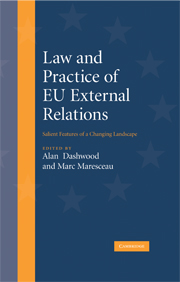Book contents
- Frontmatter
- Contents
- Abbreviations
- Notes on contributors
- Acknowledgements
- Introduction
- PART I Constitutional and institutional questions
- 1 Direct effect and interpretation of international agreements in the recent case law of the European Court of Justice
- 2 Defining competence in EU external relations: lessons from the Treaty reform process
- 3 Article 47 TEU and the relationship between first and second pillar competences
- 4 EC law and UN Security Council Resolutions – in search of the right fit
- 5 Fundamental rights and the interface between second and third pillar
- 6 The EU as a party to international agreements: shared competences, mixed responsibilities
- 7 The Common Commercial Policy enhanced by the Reform Treaty of Lisbon?
- 8 The extent to which the EC legislature takes account of WTO obligations: jousting lessons from the European Parliament
- PART II Bilateral and regional approaches
- PART III Selected substantive areas
- Table of Treaty Provisions
- Index
6 - The EU as a party to international agreements: shared competences, mixed responsibilities
from PART I - Constitutional and institutional questions
Published online by Cambridge University Press: 07 September 2009
- Frontmatter
- Contents
- Abbreviations
- Notes on contributors
- Acknowledgements
- Introduction
- PART I Constitutional and institutional questions
- 1 Direct effect and interpretation of international agreements in the recent case law of the European Court of Justice
- 2 Defining competence in EU external relations: lessons from the Treaty reform process
- 3 Article 47 TEU and the relationship between first and second pillar competences
- 4 EC law and UN Security Council Resolutions – in search of the right fit
- 5 Fundamental rights and the interface between second and third pillar
- 6 The EU as a party to international agreements: shared competences, mixed responsibilities
- 7 The Common Commercial Policy enhanced by the Reform Treaty of Lisbon?
- 8 The extent to which the EC legislature takes account of WTO obligations: jousting lessons from the European Parliament
- PART II Bilateral and regional approaches
- PART III Selected substantive areas
- Table of Treaty Provisions
- Index
Summary
Introduction
The question of whether the European Union (EU) is competent to enter into international agreements with third States and other international organisations in the non-Community areas has been subject to intense debate ever since the negotiations on the Maastricht Treaty. The main controversy behind the debate was (and to some extent still is) the unclear legal status of the EU. While the Treaty of Lisbon (TL) clearly confirms the international legal personality of the Union (Art. 47 TEU revised), the current Treaty regime remains silent on this question.
This has not prevented the EU from engaging actively in legal relations with third States and other international organisations. By now the EU has become a party to some 90 international agreements. With the increasing legal activity of the EU on the international plane, particularly reflected in the coming of age of the European Security and Defence Policy (ESDP), the question of its legal accountability becomes more prominent. Whereas the international legal responsibility of the European Community has been subject to extensive legal analysis, the same does not hold true for the European Union. It is unclear whether the EU as such may be held accountable for any wrongful act. While there are good reasons to assume that the EU already enjoyed an international legal status from the outset, this does not imply that its external relations regime is therefore also comparable to the rules we know from Community law.
- Type
- Chapter
- Information
- Law and Practice of EU External RelationsSalient Features of a Changing Landscape, pp. 152 - 187Publisher: Cambridge University PressPrint publication year: 2008
- 5
- Cited by

